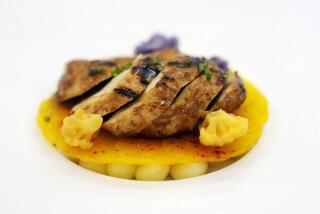Frank X.Ogasawara, 88; Leading Poultry Scientist
- Share via
Frank X. Ogasawara, one of the world’s leading poultry scientists whose pioneer studies in avian reproduction helped create the plumper, meatier turkeys that grace the nation’s tables on Thanksgiving, has died. He was 88.
Ogasawara, professor emeritus of avian and animal sciences at UC Davis, died June 8 of postoperative complications in a hospital in Davis.
Ogasawara’s most important work in avian sciences was in sperm physiology and fertilization, particularly with the technique of artificial insemination.
“He was internationally recognized in his field of avian physiology, largely reproductive physiology,” said Howard Kratzer, a former professor of avian sciences at UC Davis. “He identified sperm nests, or storage sites, for semen in the oviduct of turkey hens, which explains the long period of fertility after a single mating.
“He also did extensive work in developing methods for freezing [turkey] semen so it can be stored for long periods.”
Kratzer added that Ogasawara “worked with the reproduction of many species, which is important as a means of improving the chances of survival of endangered species and possibly of preserving genetic material.”
In the 1950s, in response to consumer demand for larger, fuller-breasted turkeys, breeders began selecting only the largest birds for breeding.
To the joy of turkey lovers, the birds that began arriving in supermarkets were more than double in size. But there was a price to pay for the meaty, heavy-chested turkeys: The male, or “tom,” turkeys became so heavy and clumsy that they had great difficulty mating with the much smaller hens.
The solution to the turkey breeders’ dilemma came with artificial insemination.
As pioneers of studying the technique in poultry in California, Ogasawara and his UC Davis colleague Fred Lorenz shared their knowledge with the state’s turkey breeders, who embraced the method.
In time, so did turkey breeders across the country, and today, virtually every turkey is bred by artificial insemination.
Artificial insemination has led to even larger turkeys: An average 1-month-old turkey weighs a tad over 2 pounds, which is nearly three times the weight of the same bird in the 1920s.
“This technique really saved the turkey industry,” Francine Bradley, a UC Davis avian scientist, told the San Francisco Weekly in 1996.
“With [artificial insemination], the industry has been very effective in producing a big, efficient bird.”
Lorenz, former chairman of UC Davis’ department of animal physiology, said Monday that after he and Ogasawara worked together, “Frank went on by himself and made some very important contributions to the whole field of avian reproduction.”
In 1966, Ogasawara was awarded the National Turkey Federation’s Outstanding Research Award for pioneering studies in avian artificial insemination.
The San Diego-born Ogasawara spent most of his childhood in Battle Mountain, Nev. He earned his undergraduate degree from UC Berkeley in 1949, and in 1957 he earned his doctorate from UC Davis, where he was appointed an assistant professor a year later.
Ogasawara, who retired as a full professor in 1983, wrote more than 80 published articles and shared his expertise widely, including lecturing in Japan, Scotland, Brazil and China.
A 1970 article he wrote for National Geographic chronicled his visit to Japan on a National Geographic Society grant to study varieties of the Japanese Onagadori, a long-tailed fowl that evolved from the common domestic chicken. (The roosters grow tail feathers that may exceed 30 feet in length.)
In 1972, after one of his graduate students found an orphaned Swainson’s hawk, Ogasawara founded the California Raptor Center at UC Davis, which rehabilitates injured and orphaned birds of prey.
About 60% of the about 250 raptors the center receives each year are returned to the wild.
The center uses the birds that cannot live on their own to educate hundreds of schoolchildren who visit the center on field trips each year, as well as the university’s veterinary and zoology students.
Ogasawara, who earned the Poultry Science Assn.’s Ralston Purina Outstanding Teacher Award in 1976, served as chairman of the USDA’s national turkey research committee from 1978 to 1979.
In 1982, he was one of five distinguished North American poultry scientists who were granted the highest honor of the Fellow of the Poultry Science Assn., in recognition of 25 years of outstanding research and teaching contributions to the American and international poultry industries.
In 1991, he was made an honorary member of the Japan Zootechnical Society.
He is survived by his wife of 57 years, Kay; two daughters, Pam of Urbana, Md., and Patty Sanui of Sacramento; and a son, Paul of Sebastopol.
More to Read
Sign up for Essential California
The most important California stories and recommendations in your inbox every morning.
You may occasionally receive promotional content from the Los Angeles Times.










